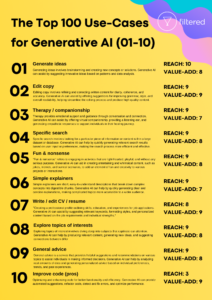Request Information
Ready to find out what MSU Denver can do for you? We’ve got you covered.
Applying Generative AI offers resources and examples for those looking to explore the capabilities of generative AI in their work. Using tutorials and demonstrations of how others are using generative AI, this page is designed to help you understand and utilize ChatGPT, Copilot, and other generative AI tools more effectively.
To take full advantage of these tools, you will need to dive in, experiment, and learn as you go. These are not your typical out-of-the-box applications like Microsoft Excel, Adobe Photoshop, or even WhatsApp. Rather, these generative AI applications have the most benefit when users interact with them and learn how to use them for their specific needs. These generative AI tools are more like the Internet than to Excel or Photoshop in that there is so much they can do but it takes time and practice to figure out the best ways to use them.

The content of this page will change as iterations are made to generative AI tools like ChatGPT and Gemini as well as to applications available to MSU Denver employees and students through our Microsoft 365 license. However, to establish a baseline understanding of generative AI, there are some “Basics of Generative AI” materials to support early learning and energize future experimentation and discovery of added uses for these applications.
For simplicity purposes, the primary resource for those looking to learn more about generative AI in its chatbot form -through tools like ChatGPT and Copilot- is a course developed by Learn Prompting, a non-profit organization focused on AI literacy that has created and launched a portfolio of free and paid resources for users to build their generative AI acumen. Learn Prompting is a trusted partner for many of the world’s largest companies and has even partnered with OpenAI (the company behind ChatGPT) to assist with training users on effective generative AI use.
The information provided in the free “ChatGPT for Everyone” module (which takes roughly 30 minutes to complete) includes valuable information for anyone interested in using generative AI including how to access and begin using ChatGPT, how to create and refine your prompts (i.e. the questions you ask a generative AI chatbot) and use cases to show users generative AI in action. This course is free but does require a “sign up.” Prior to engaging with the “ChatGPT for Everyone” content, you are encouraged to watch the short set-up via below to assist with getting started.

For those who would prefer to use Microsoft Copilot rather than ChatGPT, the information and guidance provided by Learn Prompting is applicable to both platforms. Copilot functions like ChatGPT because, frankly, Copilot is ChatGPT as Copilot uses Microsoft’s Prometheus model which has been “built upon” OpenAI’s ChatGPT-4 foundational large language model (LLM). That simply means that Microsoft is able to ensure that data from its enterprise partners can be accessed and used internally (i.e. by MSU Denver stakeholders only via our two-factor authentication process) without that information and data being used to train (and re-train) the larger OpenAI model. MSU Denver gets to use the underlying technology developed by OpenAI and the functionality that comes with it without sharing our information outside of own two-factor protected “walls.”
The Learning Prompt training remains more in-depth and useful than Copilot-specific resources currently available. It is also of value for those who prefer to use Google’s Gemini as their generative AI go-to.
Note: Future integration of Copilot into Microsoft 365 applications like Word, Excel, Teams, and PowerPoint will occur in the near future, but at the moment MSU Denver users are able to access only the cloud-based version of Copilot. Upon completion of integration, additional resources specific to Copilot will be made available. For now though, in addition to the cloud-based application, additional resources and opportunities for experimenting with Copilot’s functionality can be accessed by logging into your Microsoft 365 account and taking a look at the Copilot Lab resources collection.
A short tutorial on getting set up with Learn Prompting
This short video walks through the steps for setting up a Learn Prompting account and accessing their “ChatCPT for Everyone” module.